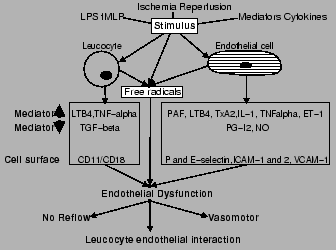



Next: Ischaemia-reperfusion injury
Up: The endothelium
Previous: No reflow phenomenum
Index
Endothelial dysfunction is present when there is an inappropriate alteration
with respect to perservation of organ function. Some of the clinical areas
where endothelial function and dysfunction are important are
ischemia-reperfusion injury, endotoxemia, diabetes, immuno-logical rejection
and dyslipidaemia.
Figure 10:
Patho-physiology of
microvascular dysfunction in ischemia-reperfusion injury , endotoxemia,
diabetes, immunological rejection and dsylipidaemia. External stimuli result
in release of free radicals and endothelial and/or leucocyte activation with
alterations in inflammatory mediators, cytokines and expression of integrins,
selectins and members of the immuno-globulin super-family. This is manifest as
endothelial dsyfunction (no-reflow phenomenum, increased leucocyte adhesion
and migration and vasomotor dsyfunction).
 |
The core pathophysiology of microvascular and endothelial dysfunction in these
conditions is outlined in figure 10.
The pathophysiology is similar despite the stimulus so ischaemia reperfusion
injury will be used to describe the process.
Subsections
Adrian P. Ireland